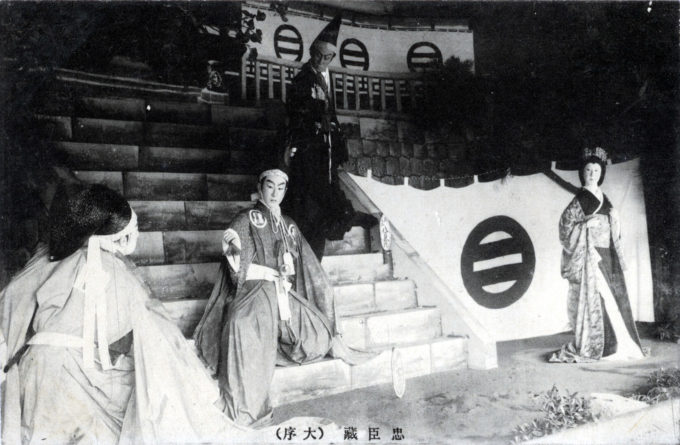
The daijo (lit. ‘big preface’, opening act) of “Chushingura”, c. 1910, one of the most important plays in the Kabuki repertoire, a retelling of the story of the 47 Ronin [‘masterless samurai’].
See also:
The 47 Ronin (Genroku Ako Vendetta).
Kabuki theater & Kabuki actors, c. 1910.
“The same holds true of a country at peace: the loyalty and courage of its fine soldiers remain hidden, but the stars, though invisible by day, at night reveal themselves, scattered over the firmament. Here we shall describe such an instance …” – Narrator, “Chushingura”
“The opening part of the first act of a Jidaimono [‘period play’] is called Daijo [lit. ‘big preface’]. At present, the only Daijo production still done is that for ‘Kanadehon chushingura’ [‘The Treasury of Loyal Retainers’]. Solemn and ceremonial Daijo scenes such as the above are used for the beginning of long, large-scale plays.
“The play was originally written for the puppet theater (Bunraku) and was staged as such for the first time in the summer of 1748 in Osaka. It was adapted for Kabuki the same year and performed for the first time in Ôsaka a few months later.
“At the very beginning the curtain is pulled aside very slowly and with great solemnity, while the piercing sound of the clappers is heard exactly 47 times before it is fully open. Each click represents one of the 47 ronin [‘masterless samurai’]. After this, a voice calls out ‘Tozai, tozai’, a phrase literally meaning ‘east, west’, but used here to call the audience’s attention rather like the English ‘hear ye, hear ye’. The phrase is called out – 7 times on the left, 5 times in the center and 3 times on the right – before the actors move. This 7-5-3 combination is auspicious.
“Meanwhile, the Gidayu shamisen enters, followed by a chanter who sets the mood. All this time the actors are seated motionless, like lifeless puppets, and it is only when the chanter mentions their names in turn that they ‘come to life’.”
– Kabuki21

